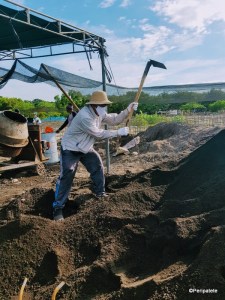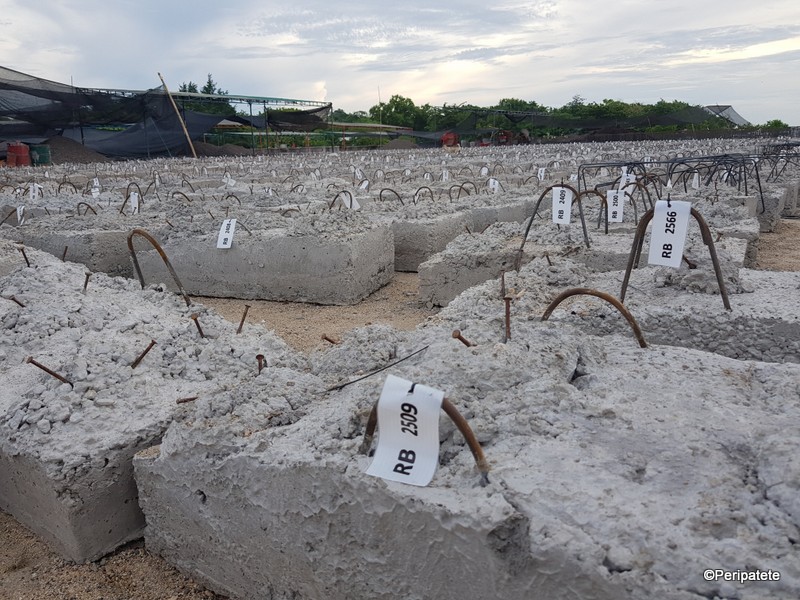Build it, and they will come. At least, that was the plan when an environmental initiative recently took root across the island. And so, the Balinese came. And still they are here, in my beach town of Sanur.
Even if they gather for the sake of a pay-cheque, the ultimate beneficiary of their daily labour is the sea: the Balinese are participating in the most extensive coral restoration undertaking this island has ever seen, along its many coastlines. Not just in Sanur, but elsewhere around Bali; Nusa Dua, Pandawa Beach, Serangan and Buleleng – under the auspices of the Indonesia Coral Reef Garden (ICRG).
After hundreds of locals were trained in the techniques used to build coral gardens, a special ceremony, called Mendem Pakelem, took place; with prayers recited for the smooth and safe unfolding of planned activities. The chair of the Bali Coral Garden Ocean Foundation, I Nyoman Sepadyana Putra, said that these prayers were directed to Sang Hyang Widhi Wasa (a.k.a. Acintya, supreme deity of the universe and origin of all life), for the tranquil and uninterrupted passage of work, on land and sea.
And with that, as a way of also injecting some much-needed movement and hope into the economy, more than 2,000 Balinese residents were hired to put in long hours at an industrial-sized, outdoor factory.
For a few weeks, I’d heard the occasional sound of male voices, sputtering through the air from the beach nearby. My curiosity piqued, I cycled down to the beach a few afternoons ago, where I was struck by these sights: A jam-packed jungle of motorbikes parked and squeezed together (ok, this… not so unusual). A sea of locals, mostly masked, standing shoulder to shoulder in improvised assembly lines; working alongside each other. There were visual diagrams posted on improvised walls, ropes strung across work zones, to warn people away from implicit danger. Hats, gloves, boots, water bottles, plenty of sweat-stained shirts and flip-flopped feet covered in mud.
Truckloads of lava from Mount Agung were being unloaded and shoveled into mountains of stones and black sand; poured into cement mixers, tethered to the electricity grid and generators by a forest of cables; then, transformed into hundreds of blocks and other steel structures – each one identified by a nickname reflecting its shape or use: ‘blocks of tofu,’ ‘crocodile bread,’ ‘hexagonal spider’ and ‘fish-dome,’ among others – all lined up in anticipation of being carted to the water, dumped and steel-anchored to the ocean’s bed.
Hundreds of grey busts representing religious deities, created out of molds filled with cement, were arranged in groupings on the ground, male and female head coverings carved out with fine details, the palms of their hands placed in prayer position; rebar protruding from either side of the torso, awaiting the attachment of further limbs. These busts, integral components of the artificial reef structures – this is Bali, after all! – would also be lowered and planted into the deep waters.
Each of these heavily constructed pieces will soon be cleared out from the beach area, removed from water’s edge and sailed out to reef regions off-shore. In time, they will begin to regenerate coral life, and to revive fish species that have diminished or gone extinct.
I don’t yet know how this massive, island-wide call for mass labour came about, but from the conversations I had with a number of sweaty souls, a subtle melody of pride underlies their toiling and dirty fingernails.
An afterthought:
The morning after my first visit, I returned to the site, aware that I’d felt shaken up by the vast array of blocks and other structures – but unable to pinpoint the cause. I needed to walk the land again, quietly, on my own, before the workforce descended. I meandered slowly, weaving a path through the sculptures and pails, the grassy knolls, the mounds of steel.
I reached a corner of the site, from where I could survey a vast swath of ‘crocodile bread’ blocks extending far off into the distance, each one tagged with a number.
I glanced around, and then I knew exactly why I’d been rankled by these surroundings. Numbered masses. Construction materials. Production on an industrial scale. It looked every bit like a stunted version of Berlin’s Holocaust Memorial – and all that it represented.
I flipped through my gallery of photos from the day before, and found this.
I swung around as I heard someone approach from behind me. I motioned to the masked woman, showed her the photo. I’d forgotten the directional rule, so I asked: Is this the Hindu swastika of prosperity and good fortune? She shook her head, glanced to either side, then whispered: Nasi.
We can find ourselves on a tropical island, millions of miles away from our home and culture, distanced by decades from a world-altering event, standing in the midst of a hopeful and generative endeavour – and still we can feel chilled by deeply embedded memories from our past.
This too, is a mystery and revelation, from this, our year of the pandemic.













Fascinating information! Thanks for the investigative journalism!
Thanks Sherry. And a truly fascinating site, as you can well imagine!